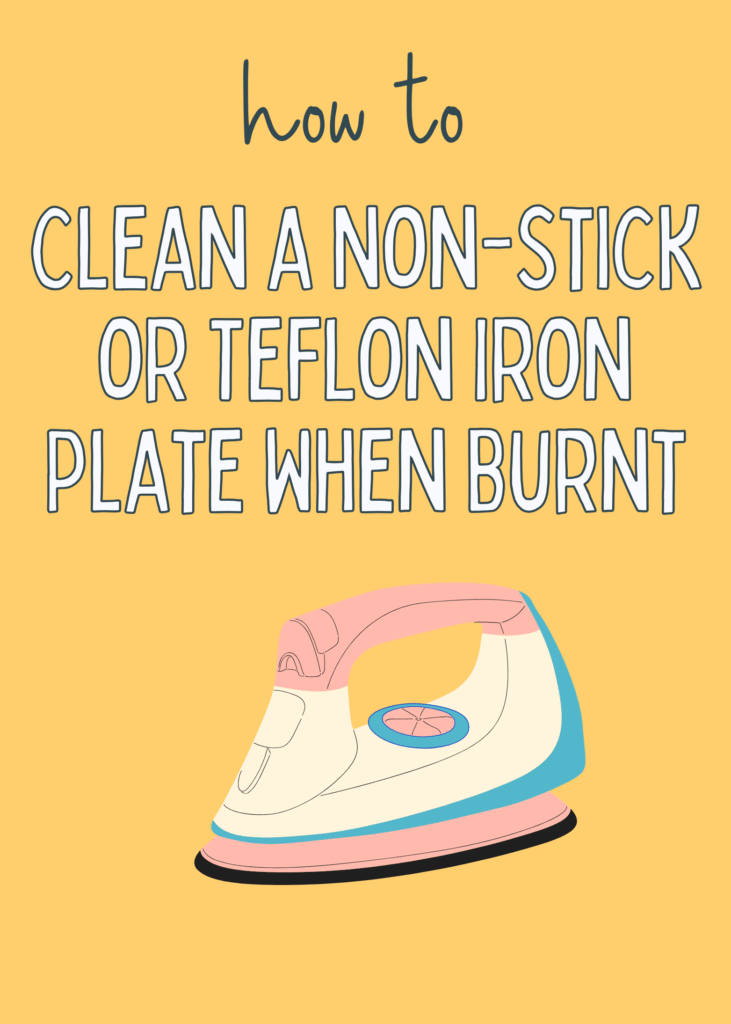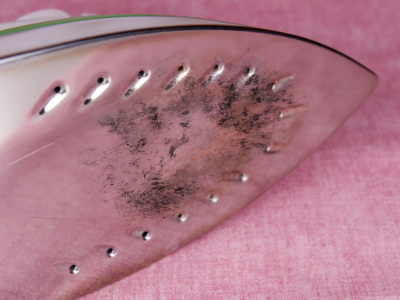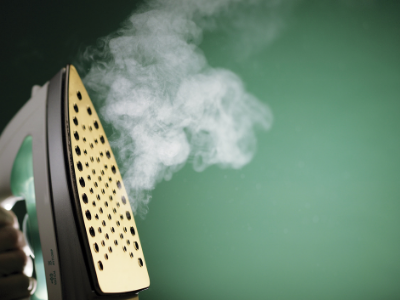* We sometimes use affiliate links, so we may receive a commission, at no cost to you, if you make a purchase through a link. Check our disclosure for more info.

If your iron has a sticky or burnt soleplate, especially a non-stick or Teflon coating, don’t panic. Cleaning a burnt iron is easy with the right methods. This guide shows you how to clean a non stick iron plate when burnt, using safe household items like vinegar, baking soda, and salt.
Learn safe, step-by-step methods to clean a non-stick or Teflon iron plate when burnt. Remove sticky residue and restore your iron fast.
Why Your Non-Stick Iron Plate Gets Sticky or Burnt
A non-stick or Teflon iron plate is designed to glide effortlessly across fabric, but over time you may notice it becoming tacky, sticky, or even developing dark burnt spots. This usually happens for a few simple reasons, and understanding them is the first step to preventing damage.
One of the most common causes is fabric residue. When you accidentally set your iron too hot for a delicate fabric, fibres can scorch or melt onto the soleplate. Synthetic materials such as polyester or nylon are especially prone to this — once they melt, they leave behind a sticky film that hardens as the iron cools.
Another culprit is starch and ironing sprays. While these products help clothes look crisp, they often build up over repeated use. Over time, that residue bakes onto the plate, creating brown marks and a less smooth surface.
Water quality also plays a role. If you regularly fill your iron with tap water, mineral deposits can form inside and around the steam vents. These deposits sometimes leak onto the soleplate, making it appear dirty or sticky. That’s why many manufacturers recommend using distilled water.
Finally, normal wear and tear can make things worse. Dust, lint, or even detergent left on clothes can transfer to the plate during ironing. If the iron isn’t cleaned regularly, these small particles accumulate and bake onto the coating.
The good news is that most of these issues are preventable. By using the right heat settings, emptying your water tank after each use, and giving your soleplate a quick wipe-down every so often, you can stop residue from turning into a major problem. And if you already have sticky or burnt marks, don’t worry — the cleaning methods below will help restore your iron.
Method 1: How to Clean a Teflon Iron With Vinegar
Vinegar is one of the safest and most effective ways to clean a non-stick or Teflon iron plate, especially if the sticky residue or burnt marks aren’t too heavy. The natural acidity breaks down grime without scratching or damaging the delicate coating.
To start, always make sure your iron is unplugged and cooled to warm, not hot. You want the soleplate slightly warm so residue softens but not hot enough to cause burns. Dampen a soft cloth or sponge with white vinegar — never pour vinegar directly on the iron. Gently rub the soleplate, focusing on the sticky or burnt patches. You should notice the buildup loosening fairly quickly.
For tougher areas, try laying a clean cotton towel on your ironing board, soaking part of it in vinegar, and then pressing the warm iron onto the damp section. Letting the steam activate with vinegar helps dissolve stubborn residue. Once loosened, wipe the plate clean with a fresh cloth dipped in plain water.
If the steam vents are blocked, dip a cotton swab in vinegar and gently clear each opening. Run a quick steam cycle afterwards with clean water to flush out any remaining vinegar.
The key with vinegar cleaning is patience and gentleness. Never use harsh scrubbing pads or sharp tools, as these will permanently damage a non-stick soleplate. Once your plate looks clean again, heat the iron briefly and run it over an old towel to ensure no residue remains.
Regular vinegar cleaning is especially helpful if you use starch sprays, as it prevents buildup before it turns brown and sticky. Done once a month, this simple method can keep your Teflon iron gliding smoothly and extend its life considerably.
Method 2: How to Clean a Non-Stick Iron Plate With Baking Soda
Baking soda is another powerful cleaning ally, especially when your iron has heavier burnt patches that vinegar alone can’t shift. It works as a gentle abrasive, lifting grime without scratching a Teflon or non-stick coating.
Begin with a completely cool, unplugged iron. Mix two tablespoons of baking soda with one tablespoon of water to create a thick paste. The paste should be spreadable but not runny. Using a soft cloth or sponge, apply the mixture directly to the burnt or sticky areas of the soleplate. Avoid packing it into the steam vents — you only want it on the flat surface.
Next, rub the paste in small circles across the affected areas. You’ll feel the slightly gritty texture working to loosen residue. Keep the pressure light; the paste does the work without force. After a few minutes of rubbing, wipe the plate clean with a damp cloth. Make sure all paste is removed, as leftover baking soda could flake onto your clothes during the next ironing session.
For really stubborn spots, repeat the process or leave the paste sitting on the area for five to ten minutes before wiping. Just don’t let it harden completely, as that makes removal more difficult.
When you’re satisfied, heat the iron slightly and run it over an old towel. This helps clear out any remaining debris and ensures the plate is smooth again. If needed, give the steam vents a quick wipe with a cotton swab dipped in water.
The baking soda method is particularly useful if you’ve accidentally melted synthetic fabric onto the soleplate. It’s strong enough to tackle burnt plastic residue without harming the Teflon finish. Used sparingly, this approach can restore even heavily marked irons back to near-new condition.
Method 3: How to Clean a Burnt Iron Soleplate With Salt
Salt might seem like an odd cleaning tool, but it’s surprisingly effective at removing burnt residue from an iron soleplate. The trick is to use it as a natural abrasive — strong enough to lift grime but gentle enough not to damage non-stick coatings when applied correctly.
Start by placing a sheet of baking paper (or even a brown paper bag) on your ironing board. Sprinkle a generous layer of ordinary table salt across it. Heat your iron to a medium setting — too hot and the paper could scorch, too cool and the residue won’t lift.
Once the iron is warm, glide it slowly back and forth over the salted paper. The salt crystals act like tiny scrubbers, loosening burnt patches as the heat softens them. You may need to repeat the process several times, adding fresh salt each round, until you see the residue breaking away.
Afterwards, allow the iron to cool slightly and wipe the soleplate with a clean, damp cloth. This removes any remaining salt or loosened debris. For extra shine, finish with a quick rub of vinegar on a cloth.
This method works best for burnt-on residue that feels rough to the touch but hasn’t deeply fused into the Teflon surface. It’s also a great maintenance trick if you use your iron regularly on natural fibres like cotton and linen, which can leave scorch marks.
One word of caution: avoid using coarse rock salt or pressing down too firmly. Both can scratch a non-stick soleplate. Stick with fine table salt and a gentle gliding motion.
Used occasionally, this salt method is a fast, no-mess way to refresh your iron without needing special cleaners. Many people swear by it for restoring glide and preventing those annoying black streaks on freshly washed clothes.
What Not to Do When Cleaning a Non-Stick Iron
Knowing how to clean your iron is important, but knowing what not to do is just as vital. Non-stick and Teflon plates are delicate, and one wrong move can permanently damage the surface, making your iron useless.
First, never use metal tools or sharp objects to scrape off burnt residue. Knives, scissors, or razor blades might seem effective, but they’ll scratch the coating instantly. Once scratched, a non-stick iron plate can snag fabric and spread marks onto your clothes.
Similarly, avoid abrasive cleaning pads like steel wool or scouring sponges. These create micro-scratches that weaken the surface and trap dirt even more quickly. Stick to soft cloths, cotton swabs, or non-abrasive sponges.
Another common mistake is using harsh chemicals. Bleach, ammonia, and strong oven cleaners can react badly with the soleplate coating, leaving it discoloured, sticky, or weakened. Household solutions like vinegar and baking soda are far safer and just as effective.
Don’t immerse your iron in water either. While it might seem like the fastest way to clean, water entering the electrical components can cause serious damage or even pose a safety risk. Always clean the soleplate with the iron unplugged, using a damp cloth rather than soaking.
Finally, don’t forget the temperature factor. Trying to clean a very hot iron is risky and often counterproductive. The heat can cause vinegar or baking soda to dry too fast, leaving streaks or stains. Aim for warm (not hot) when cleaning the plate, and cool when applying any paste-based method.
By avoiding these mistakes, you’ll protect the life of your non-stick iron and make sure every cleaning attempt is safe and effective. Prevention is always easier than repair, but careful cleaning done the right way will keep your iron working smoothly for years.
Tips to Prevent Burnt Residue on Irons
Once you’ve gone through the effort of cleaning your iron, it makes sense to keep it that way. A few small habits can prevent burnt residue from forming in the first place, saving you time and extending the life of your appliance.
The most important tip is to always match your iron’s heat setting to the fabric you’re pressing. Check the clothing label before you begin — ironing polyester or nylon on a cotton setting is the fastest way to end up with melted fibres stuck to your soleplate.
Using distilled water in the tank can also make a big difference. Tap water often contains minerals that clog steam vents and leak onto the soleplate, leaving behind stains and residue. Emptying the tank after each use helps too, as it prevents stagnant water and mineral buildup.
After ironing, give the plate a quick wipe with a damp cloth while it’s still slightly warm (but unplugged). This simple step clears away starch, dust, and lint before they have a chance to bake onto the surface. If you use spray starch, consider applying it directly to the garment rather than in the path of the iron. This cuts down on sticky buildup dramatically.
Storage matters as well. Always keep your iron upright when not in use. Laying it flat, even for a short while, can trap heat and residue against the soleplate. Using a heat-resistant rest pad also reduces the risk of accidental scorching.
Finally, schedule a deep clean once a month if you iron frequently. Rotate between vinegar, baking soda, and salt methods depending on how dirty the plate gets. Preventative care only takes a few minutes but will keep your iron performing like new — no sticky surprises and no burnt marks on your freshly pressed clothes.


